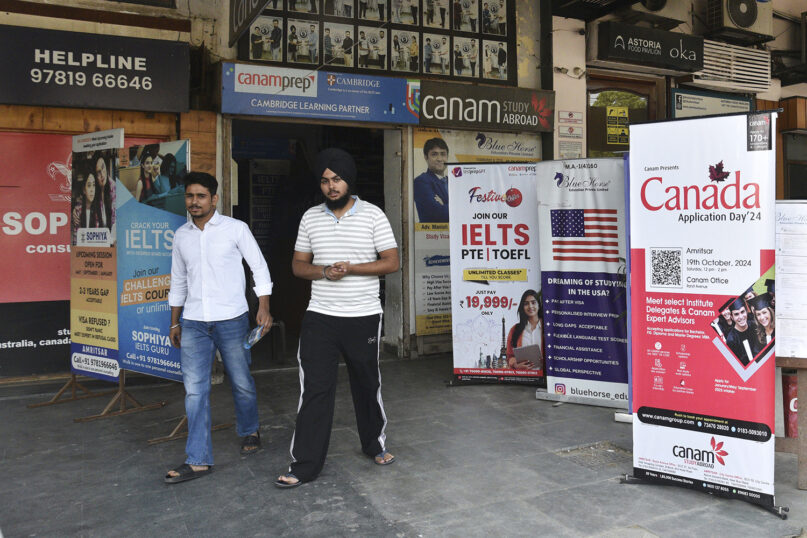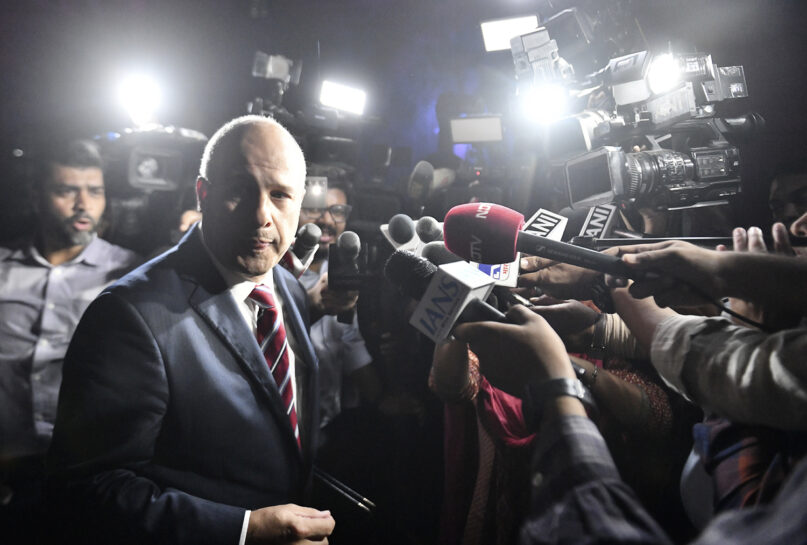(RNS) — In early October, the Sikh temple in Fremont, California, released a statement on its Facebook page, speaking out against what it calls a “new wave of Indian propaganda,” referring to recent allegations by Hindu American groups that the temple, a spiritual home to Sikhs in the Bay Area since 1978, was involved in “organized crime.”
The Facebook post accused organizations “aligned with the Indian government” of labeling Sikhs as extremists in a grassroots fight going on in northern India to establish an independent Sikh state called Khalistan. “Such efforts to stigmatize Sikhs are both unfounded and harmful,” the statement read. The leaders of the gurdwara, as Sikh temples are called, protested that their advocacy for an independent Sikh state have been “legitimate and peaceful.”
When India and Canada expelled each other’s diplomats in the past few days, the exchange escalated a tussle over a rash of attacks on Sikhs living in Canada in recent years and spurred headlines around the globe, many of them attempting to demystify the fight over a non-existent state of Khalistan involving shadowy intelligence operatives and accusations of government-sponsored murder, in the United States as well as Canada.
But for Sikhs in the two countries, there is nothing murky about the controversy. The Khalistan movement — a campaign to establish an independent homeland for Sikhs in Punjab, a region split between northern India and Pakistan — has long been on the minds of Sikh Americans. In 2023, thousands of Sikhs in San Francisco turned out to vote in a symbolic referendum on Khalistan, and the Khalistani cause, these Sikhs say, pushes back against age-old discrimination to claim self-determination and sovereignty.
The movement has been associated with violent rhetoric and action. In 1985, pro-Khalistan extremists planted a bomb aboard an Air India flight, killing all 329 people on the plane, one of the deadliest terrorist attacks in Canadian history.
More recently Hindu temples in the U.S. have seen statues toppled and walls marred by pro-Khalistani and anti-Indian graffiti. Anti-Hindu hate crimes, say many Hindu Americans, ratcheted up after a spat between a Sikh with a map of Khalistan on his arm was videoed by a Hindu customer at a Fremont Taco Bell and went viral in 2021.
The current diplomatic conflict stems from alleged assassination plots targeting two activists belonging to a group called Sikhs for Justice, Gurpatwant Singh Pannun and Hardeep Singh Nijjar, the latter of whom had been accused of helping to train others to carry out terrorist acts against India. After Nijjar, who was a 45-year-old Canadian citizen, was killed in a drive-by shooting at his gurdwara in Vancouver in June 2023, Canada Prime Minister Justin Trudeau said there were “credible allegations” that Indian government agents were involved.

People walk past banners inviting students to study in Canada and other places abroad at a market in Amritsar, in the northern Indian state of Punjab, Tuesday, Oct. 15, 2024. (AP Photo/Prabhjot Gill)
In August this year, another Sikhs for Justice leader, Satinder Pal Singh Raju, said he, too, was targeted while driving on a freeway near Sacramento, California. On Thursday (Oct. 17), an Indian national, Vikash Yadav, was convicted of a murder-for-hire scheme against Pannun.
The revelations have been “breathtaking” for Harman Singh, the executive director of advocacy organization Sikh Coalition. “In the past year and a half, what we’ve obviously recognized is that there’s a new threat to members of the Sikh community here in the United States,” he said. “Those are threats that are emerging from the Government of India targeting Sikhs who are here on U.S. soil.
“We’ve heard from Sikh houses of worship, Sikh academics, Sikh journalists and individual members of the community who have all told us that in some form or another they are concerned about the issue of transnational repression,” he said. “Our position is that anyone within any religious community should have the freedom and the ability to talk about their political and religious views in a lawful way without being targeted by a foreign government.”
The Sikh Coalition, founded after the 9/11 attacks in response to “individual and institutional discrimination” of the Sikh American diaspora, has never taken an official stance on Khalistan, in part, Singh said, because Sikhs disagree on how it would be created. But when “all Sikhs are conflated with Khalistanis, and all Khalistanis are seen as terrorists,” he said, all Sikhs are threatened.
Raising tensions further is the 40th anniversary of Operation Blue Star, the bloody 1984 storming of the Golden Temple in Amritsar by Indian troops in pursuit of Sikh militants. Months later, Prime Minister Indira Gandhi was assassinated in retaliation.
Harjeet Singh, a Sikh who lives in Seattle, said he feels a “sense of relief,” despite the violence, that the Western world is now paying attention to these dynamics. For years, he says, Sikhs have been questioned at the customs line on entering his home country of India.
“Anybody who says anything that the Indian government doesn’t like, whether you’re supporting a farmer’s protest or you’re supporting just basic human rights, they’ll put the label of “Khalistani” on that person and then try to kind of go after them as an extremist,” said Singh, the host of a podcast called “Finding Truth with Harjeet.”
Although the movement is made up mostly of Sikhs, Singh sees the movement as not religious but a push for “decentralization of power from the hands of an overbearing government.” Advocates hope for control of laws, taxation and resources for the large Punjabi-speaking community. (Not all, he adds, belong to or trust the leadership of Sikhs for Justice.)
Some Sikhs are wary of Khalistani activism of any kind. Puneet Sahani is an anti-Khalistani social media activist who works to raise awareness of the dangers of Khalistani ideology. In speaking with other Sikhs, Sahani said, he has heard growing discouragement about the politicization of Sikh houses of worship. Many in the diaspora are being “brainwashed,” he said, with the idea of “revenge for 1984” or “hatred for Hindus and India.”
Sahani stopped attending his local gurdwara for similar reasons four years ago. “Of course, I miss the congregation, because like, you’re supposed to participate in the community,” he said. “But what the gurus are basically saying is you fight for dharma (religious duty). I am taking inspiration from my gurus, doing my dharma and fighting a dharma-yuddha (holy war). Our gurus inspire us to be the first in line to defend Bharat,” using a Hindu word for India.
Mat McDermott, senior communications director of the Hindu American Foundation, said in a statement that Hindu and Sikh American communities have historically lived in harmony and that recent events are not representative.

Canada Deputy High Commissioner to India Stewart Wheeler speaks to media personnel after meeting with officials at the Indian government’s Ministry of External Affairs, in New Delhi, India, Monday, Oct. 14, 2024. (AP Photo)
McDermott said he was surprised by “the degree this has become a highly public and politicized spectacle,” even as questions about India’s intentions remain unanswered. “This information vacuum,” he said, “combined with the sheer intensity of the allegations, and the differing approaches the U.S. government has employed with various South Asian communities, have naturally created a perfect storm for fear, suspicion and ultimately tensions between communities.
“The DOJ cannot expect to maintain a comprehensive investigative and enforcement capacity to handle such issues if it is disconnected from a community or is perceived to be dismissive of a community’s concerns,” said McDermott. “They must also consider their power to bring communities together, or tear them apart through their actions. That will ultimately make more of a difference to the various Dharmic communities here than anything else.”
Harman Singh pointed out that Bay Area Sikhs helped clean spray paint from a vandalized Hindu temple. “We’ve seen the pain that comes when houses of worship are targeted,” he said, “in Punjab in 1984 and in Oak Creek, Wisconsin, in 2012,” the site of a mass shooting by a white assailant. “This is personal to us.”
Michael Rubin, a senior fellow at the American Enterprise Institute who studies South Asia and the Middle East, said American lawmakers have a responsibility to “recognize, chart and map” how pro-Khalistan extremists in the Sikh community “risk perhaps eviscerating or taking over the infrastructure and the organizations of the largely peaceful and successful American Sikh community.”
“I suspect that your ordinary Sikh has more to fear from the Khalistani extremists within their community than from the government of India,” he said.

